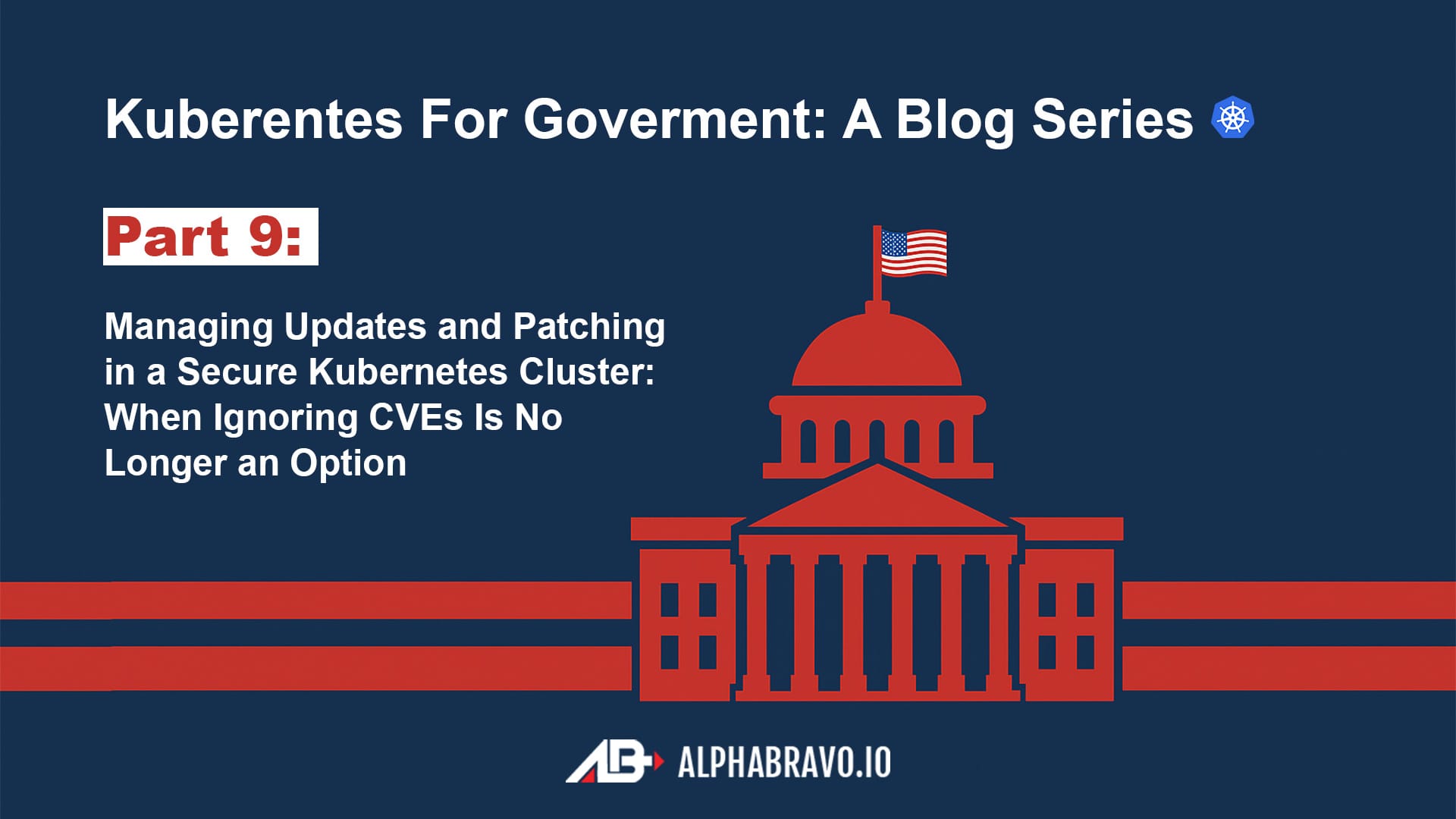Managing Updates and Patching in a Secure Kubernetes Cluster: When Ignoring CVEs Is No Longer an Option (Part 9)

In the high-stakes world of government Kubernetes deployments, patch management isn't just an IT chore-it's practically a national security imperative. If you've been following our deep dive series on Kubernetes in government environments, you already understand the unique compliance challenges and security requirements these deployments face. Now, we turn our attention to perhaps the most persistent operational challenge: keeping your clusters patched and updated without sacrificing availability or security posture.
The Never-Ending Patch Cycle: A Government Administrator's Nightmare
Picture this: You've just finished your morning coffee, settled into your ergonomic government-issued chair (which somehow still manages to be uncomfortable), when an urgent notification appears-a new critical Kubernetes vulnerability has been discovered. Your peaceful morning has just transformed into a high-pressure race against potential attackers.
This scenario isn't hypothetical. In April 2025, the Kubernetes project released patches for critical vulnerabilities in the Ingress Nginx Controller, affecting an estimated 43% of internet-facing Kubernetes clusters. For government systems, particularly those operating at Impact Level 4 or higher, such vulnerabilities aren't just inconvenient-they represent potential national security risks.
Managing these updates in government environments presents unique challenges:
- Strict change control procedures that can delay urgent patches
- Compliance requirements that mandate comprehensive documentation
- The need to maintain availability for mission-critical systems
- Air-gapped environments that complicate update mechanisms
- The complexity of multi-cluster architectures common in DoD deployments
As one system administrator lamentably told me, "In the commercial world, patching is a continuous improvement process. In government, it's more like continuous documentation."
DISA STIGs: The Gospel of Government Kubernetes Security
For the uninitiated, Defense Information Systems Agency (DISA) Security Technical Implementation Guides (STIGs) are the authoritative standards for securing systems that communicate with Department of Defense networks. The Kubernetes STIG, now in its latest iteration, contains 91 rules covering various aspects of Kubernetes security.
DISA requirement V-242443, for example, explicitly states: "Kubernetes software must stay up to date with the latest patches, service packs, and hot fixes." The check for compliance involves verifying that the Kubernetes version supports the current skew policy.
The rationale is clear: "Not updating the Kubernetes control plane will expose the organization to vulnerabilities. Flaws discovered during security assessments, continuous monitoring, incident response activities, or information system error handling must also be addressed expeditiously."
Achieving and maintaining STIG compliance for your Kubernetes clusters requires a systematic approach:
- Establish a baseline: Document your current Kubernetes version and components
- Assess against STIGs: Evaluate your environment against current STIG requirements
- Remediate gaps: Implement necessary controls and updates
- Validate: Verify that remediation actions are effective
- Document: Maintain evidence of compliance for audit purposes
Several tools can help automate STIG compliance checking, including kube-bench for CIS Benchmark verification (which aligns with many STIG requirements) and Sysdig Secure for continuous compliance monitoring.
The Art and Science of CVE Management
Common Vulnerabilities and Exposures (CVEs) are the currency of the cybersecurity world. For Kubernetes environments, staying ahead of these vulnerabilities requires a comprehensive approach.
Step 1: Establish a Vulnerability Management Process
Your process should include:
- Regular scanning: Implement automated vulnerability scanning tools that check your Kubernetes clusters, container images, and associated components
- Prioritization framework: Not all CVEs pose the same level of risk; develop a method to assess impact based on your environment
- Remediation planning: Create standard procedures for addressing different types of vulnerabilities
- Testing protocol: Define how patches will be validated before deployment to production
Step 2: Understand Your Environment's Attack Surface
Kubernetes presents a diverse attack surface, including:
- Control plane components (API server, scheduler, controller manager)
- Worker node components (kubelet, kube-proxy)
- Container runtime
- Network plugins
- Storage providers
- Ingress controllers and other add-ons
- Application containers themselves
Each component requires its own patching strategy and cadence.
Step 3: Prioritize Based on Risk, Not Just CVSS Scores
While the Common Vulnerability Scoring System (CVSS) provides a useful baseline, effective prioritization requires considering:
- Whether the vulnerability is being actively exploited
- If it affects internet-facing components
- The sensitivity of potentially impacted data
- Mitigating controls already in place
- Operational impact of the patch
For example, a recent critical vulnerability in the Kubernetes Ingress Nginx Controller received a CVSS score of 9.8 due to the risk of remote exploitation, making it an urgent patching priority for exposed clusters.
Practical Patching Strategies for Government Kubernetes
Government Kubernetes environments typically fall into one of several deployment patterns, each requiring a tailored patching approach:
On-Premises Clusters
On-premises clusters, particularly common in government environments due to security requirements, present unique patching challenges. Based on a real-world case reported by a Kubernetes administrator, patching an on-premises cluster manually can take over two hours to patch and reboot all nodes.
Recommended approach:
- Implement automation through configuration management tools
- Create node drain/cordon scripts to minimize workload disruption
- Consider maintaining a standby node that can accept workloads during patching
- Use node labels to create patch groups for phased updates
Managed Kubernetes Services
For government agencies leveraging managed Kubernetes services like Oracle Cloud Infrastructure's Private Cloud Appliance with Kubernetes, patching becomes a more structured but still complex process.
Oracle's documentation notes: "Upgrading or patching the Kubernetes cluster is a time-consuming process... Each additional compute node extends the process by approximately 10 minutes for each incremental version of Kubernetes."
Key considerations:
- Understand the provider's patching methodology
- Review the upgrade plan generated by pre-upgrade commands
- Schedule maintenance windows aligned with service requirements
- Validate that patching hasn't affected custom configurations
Air-Gapped Environments
Air-gapped environments, common in higher impact levels (IL5/IL6), require special consideration:
- Maintain an internal, validated repository of Kubernetes components
- Implement rigorous testing in a staging environment before production deployment
- Create detailed rollback procedures for when things inevitably go sideways
- Document the provenance of all patches for security validation
Automation: Your Secret Weapon Against Patch Fatigue
Manual patching in complex Kubernetes environments is not just tedious-it's a recipe for inconsistency and human error. Automation is essential for efficient and reliable patch management.
CI/CD Pipelines for Infrastructure
Implement GitOps-based approaches for infrastructure management:
# Example of a pipeline stage for Kubernetes patching
stages:
- validate
- apply
- verify
validate-patch:
stage: validate
script:
- kubectl apply --dry-run=client -f ${PATCH_FILE}
- ./run-security-tests.sh
apply-patch:
stage: apply
script:
- kubectl patch deployment ${DEPLOYMENT_NAME} --patch-file ${PATCH_FILE}
when: manual # Requires explicit approval
verify-patch:
stage: verify
script:
- ./verify-deployment-health.sh ${DEPLOYMENT_NAME}
Strategic Use of kubectl patch
The kubectl patch command is particularly useful for making targeted changes without replacing entire configuration files. For example, to update a container image in a deployment:
kubectl patch deployment python-app -p '{"spec": {"template": {"spec": {"containers": [{"name": "testapp", "image": "nginx:1.16"}]}}}}'
This approach allows for precise updates with minimal risk and is ideal for automation.
Automation Considerations for Government Environments
Government environments often have additional requirements for automation:
- Change approval workflows must be integrated
- Audit logs must be comprehensive
- Role-based access controls must be strictly enforced
- Automated rollbacks must be reliable
Minimizing Downtime: The Holy Grail of Government Patching
For mission-critical government systems, downtime isn't just an inconvenience-it can impact national security operations. Several strategies can help minimize disruption during patching:
Rolling Updates
Kubernetes natively supports rolling updates, but they must be configured correctly:
spec:
replicas: 3
strategy:
type: RollingUpdate
rollingUpdate:
maxUnavailable: 1
maxSurge: 1
By setting appropriate maxUnavailable and maxSurge values, you ensure that service capacity remains adequate throughout the update process.
Node Draining Strategy
For node-level patches requiring reboots, implement a careful draining strategy:
- Mark the node as unschedulable:
kubectl cordon - Gracefully evict pods:
kubectl drain --ignore-daemonsets - Apply patches and reboot
- Verify node health:
kubectl get nodes -o wide - Re-enable scheduling:
kubectl uncordon
Blue-Green Deployments for Critical Services
For the most sensitive workloads, consider implementing blue-green deployment patterns:
- Create a parallel "green" environment with the updated configuration
- Test thoroughly
- Switch traffic from "blue" to "green" once validated
- Maintain "blue" as a fallback until "green" proves stable
Testing and Validation: Trust But Verify
The government mantra of "trust but verify" applies doubly to Kubernetes patching. Comprehensive testing is essential before deploying patches to production environments.
Pre-Deployment Testing
Before applying patches to production:
- Dry-run execution: Use
kubectl apply --dry-run=clientto validate syntax and expected outcomes - Staging environment validation: Deploy to a representative non-production environment
- Automated test suite execution: Verify that core functionality remains intact
- Security testing: Confirm that the patch effectively addresses the vulnerability
- Performance benchmarking: Ensure performance hasn't degraded
Post-Deployment Validation
After applying patches:
- Health checks: Verify all components are operational
- Security scans: Confirm vulnerability remediation
- Compliance validation: Re-assess against STIG requirements
- User acceptance testing: Validate critical business functions
Documentation and Compliance: Proving You Did It Right
In government environments, it's not enough to apply patches correctly-you must prove you did so. This documentation serves both operational and compliance purposes.
Patch Management Records
Maintain comprehensive records including:
- Vulnerability details (CVE ID, severity, affected components)
- Patch details (version, source, validation methods)
- Implementation timeline (approval, deployment, verification)
- Test results and validation evidence
- Rollback plan (if needed)
Demonstrating Compliance to Auditors
To effectively demonstrate compliance to auditors, implement these practices:
- Maintain before/after evidence: Document the vulnerability and subsequent remediation
- Implement automated compliance checking: Use tools that can verify STIG compliance continuously
- Create audit-ready reports: Generate reports showing compliance status over time
- Document exceptions with justification: For any exceptions, provide risk acceptance documentation
Real-World Challenges and Solutions
Challenge: Securing Kubernetes in Multi-Cluster Environments
Government agencies often operate multiple Kubernetes clusters across different security domains. This complexity can make consistent patching difficult.
Solution: Implement a centralized patch management system that tracks the patch status of all clusters. Use tools like Rancher or Anthos Config Management to deploy consistent policies across clusters.
Challenge: Maintaining Update Compliance in Air-Gapped Environments
Many government Kubernetes deployments operate in air-gapped environments without direct internet access.
Solution: Establish a secure process for transferring validated updates into the environment:
- Download updates to an internet-connected staging environment
- Validate and scan the updates for security issues
- Transfer via approved cross-domain solution
- Verify integrity after transfer
Challenge: Managing Container Image Updates
Keeping container images updated is as important as patching Kubernetes itself.
Solution: Implement a container image lifecycle management strategy:
- Use a private container registry with scanning capabilities
- Automate image rebuilding when base images are updated
- Implement policies that prevent deployment of outdated images
- Consider Iron Bank hardened containers for government deployments
The Human Element: Building a Patch-Friendly Culture
Technical solutions are only part of the equation. Creating a culture that prioritizes security updates is equally important.
- Training and awareness: Ensure all team members understand the importance of patching
- Clear responsibilities: Define who is responsible for monitoring, approving, and implementing patches
- Realistic SLAs: Set appropriate timeframes for different severity levels
- Recognition: Acknowledge teams that maintain strong patch compliance
One DoD Kubernetes administrator put it well: "We don't celebrate the patches we apply-we celebrate the incidents we prevent."
Looking Ahead: Beyond Reactive Patching
As your Kubernetes practice matures, aim to shift from reactive to proactive security. This includes:
- Vulnerability prediction: Analyzing patterns to anticipate potential issues
- Chaos engineering: Deliberately testing failure scenarios to improve resilience
- Supply chain security: Securing the entire software supply chain, not just the runtime environment
In our next installment, "Lessons Learned: Optimizing and Scaling Kubernetes for Government Workloads," we'll explore how these mature practices fit into a broader strategy for operating Kubernetes at scale in government environments. We'll examine how the security foundation established through rigorous patching supports advanced scaling patterns and performance optimization techniques for mission-critical workloads.
Until then, remember that in the world of government Kubernetes, patching isn't just about security-it's about mission readiness. As they say in the Pentagon, "Updating your clusters today keeps the adversaries away."
Ready to take your government Kubernetes deployments to the next level? Stay tuned for our next deep dive.

